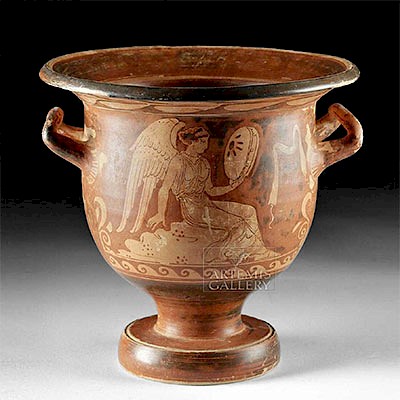Maya Pottery Ulua Valley Tripod Cylinder
Lot 160a
About Seller
Artemis Gallery
686 S Taylor Ave, Ste 106
Louisville, CO 80027
United States
Selling antiquities, ancient and ethnographic art online since 1993, Artemis Gallery specializes in Classical Antiquities (Egyptian, Greek, Roman, Near Eastern), Asian, Pre-Columbian, African / Tribal / Oceanographic art. Our extensive inventory includes pottery, stone, metal, wood, glass and textil...Read more
Estimate:
$1,000 - $1,500
Absentee vs Live bid
Two ways to bid:
- Leave a max absentee bid and the platform will bid on your behalf up to your maximum bid during the live auction.
- Bid live during the auction and your bids will be submitted real-time to the auctioneer.
Bid Increments
| Price | Bid Increment |
|---|---|
| $0 | $25 |
| $300 | $50 |
| $1,000 | $100 |
| $2,000 | $250 |
| $5,000 | $500 |
| $10,000 | $1,000 |
| $20,000 | $2,500 |
| $50,000 | $5,000 |
| $100,000 | $10,000 |
| $200,000 | $20,000 |
About Auction
By Artemis Gallery
Mar 7, 2019
Set Reminder
2019-03-07 10:00:00
2019-03-07 10:00:00
America/New_York
Bidsquare
Bidsquare : VARIETY SALE | Antiquities & Ethnographic Art
https://www.bidsquare.com/auctions/artemis-gallery/variety-sale-antiquities-ethnographic-art-3928
Around the world & back in time - be amazed at the treasures you will find. Antiquities from Egypt, Greece, Italy and the Near East, Asian, Pre-Columbian, African / Tribal / Oceanic, Native American, Spanish Colonial, Russian Icons, Fine Art, much more! Artemis Gallery info@artemisgallery.com
Around the world & back in time - be amazed at the treasures you will find. Antiquities from Egypt, Greece, Italy and the Near East, Asian, Pre-Columbian, African / Tribal / Oceanic, Native American, Spanish Colonial, Russian Icons, Fine Art, much more! Artemis Gallery info@artemisgallery.com
- Lot Description
Pre-Columbian, Honduras, Mayan Ulua Valley, ca. 550 to 850 CE. An iconographically dense, brightly painted cylinder with low, tripod legs. In three registers around the body are bands of richly painted symbols in red, orange, deep brown, and an earthy cream color. The upper and lower registers have glyphoid forms with thick black horizontal bands set inside a thin red border. Between those is a larger register that contains a repeated image of a seated figure wearing a large feathered belt, kneeling as if making an offering, with the repeated image separated by a thick black diagonal band with incised geometric motifs. Size: 7" W x 9" H (17.8 cm x 22.9 cm)
The Ulua Valley is sometimes referred to as the Mesoamerican Frontier, the place where the lowlands of the Maya met the lower part of Central America and its different cultures. They are famous for producing marble and polychrome ceramic cylinders that were traded far and wide. For the Maya, extraordinary painted ceramic vases like this example were gifted to elite individuals, akin to the gifts exchanged between high profile dignitaries today. Vases were a functional gift, created by artist/scribes who came from elite families and who took pains to recreate the stories of Mayan mythology and religion as well as to depict royal and godly personages in their artwork.
Provenance: private New York, New York, USA collection; purportedly deaccessioned from Museum of World Treasures, Wichita, Kansas, USA
All items legal to buy/sell under U.S. Statute covering cultural patrimony Code 2600, CHAPTER 14, and are guaranteed to be as described or your money back.
A Certificate of Authenticity will accompany all winning bids.
We ship worldwide and handle all shipping in-house for your convenience.
#143573Two repaired hairline cracks down from the rim, with no added clay or overpaint. Nice preservation of motifs, with clear iconography. Small chips and nicks from peripheries.Condition
- Shipping Info
-
All shipping is handled in-house for your convenience. Your invoice from Artemis Gallery will include shipping calculation instructions. If in doubt, please inquire BEFORE bidding for estimated shipping costs for individual items.
-
- Buyer's Premium



 EUR
EUR CAD
CAD AUD
AUD GBP
GBP MXN
MXN HKD
HKD CNY
CNY MYR
MYR SEK
SEK SGD
SGD CHF
CHF THB
THB
















